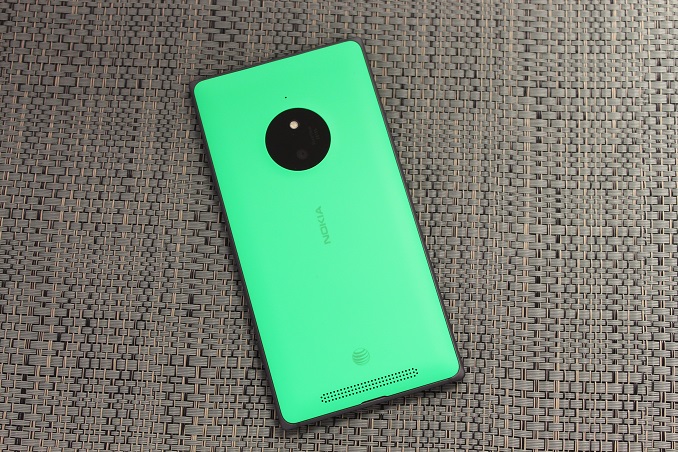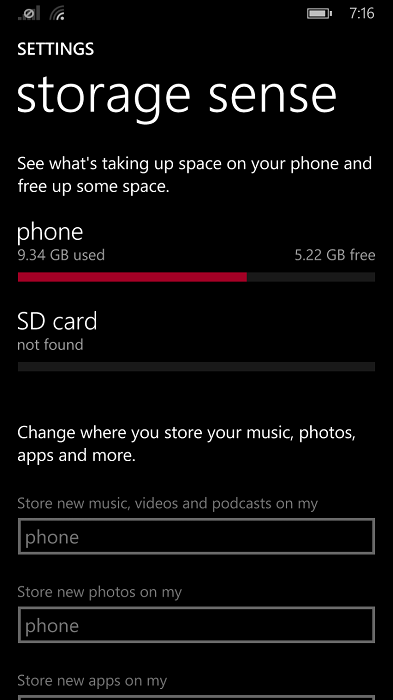Nokia Lumia 830 Review
by Brett Howse on November 25, 2014 8:00 AM EST- Posted in
- Smartphones
- Microsoft
- Lumia

The Lumia 830 was launched by Microsoft at the IFA trade show in September. As seems to be the norm for most Nokia phones, it has taken a short while for announced phones to be generally available, but the Lumia 830 can now be found in many markets. When it was announced in September, it was marketed as an “affordable flagship” and we will take a look and see how it lives up to that kind of marketing. But marketing phrases aside, what we are left with is one of the best Nokia phones launched this year.
Unfortunately for fans of Nokia phones, there has not been a real flagship phone announced since the Lumia Icon/930 which came back in February. We did review that phone, and while it was quick and had a nice 20 MP camera, the battery life was subpar and it felt very thick and dense to carry around. It lacked Nokia’s Glance display, which is a big downside when coming from previous Nokia phones that support it.
The Lumia 830 is not going to fill a gap here as far as performance, which is a shame. The Lumia 830 shares the same SoC – the Qualcomm Snapdragon 400 – as the Lumia 630, 635, 730, and 735. There is no substitute for performance, and the quad-core Cortex A7 at 1.2 Ghz is not the quickest chip around. In the Lumia 630 review, I found the quad-core A7 design slightly slower than the dual-core Krait of last year’s Snapdragon S4 Pro in pretty much all benchmarks. It is a shame due to the marketing and price of the Lumia 830 that it did not jump up to at least the Snapdragon 600. With that SoC, perhaps the moniker of “affordable flagship” could have held up.
Let us take a look at what makes up the Lumia 830.
| Nokia Lumia 830 | |
| SoC | MSM8926 1.2 GHz Snapdragon 400 |
| RAM/NAND | 1 GB LPDDR2, 16 GB NAND + microSD 128 GB |
| Display | 5.0” 1280x720 IPS ClearBlack LCD Corning Gorilla Glass 3 |
| Network | GSM/GPRS/EDGE/HSPA/LTE up to 150 Mbps |
| Dimensions | 139.4 x 70.7 x 8.5 (mm) |
| Weight | 150 grams |
| Rear Camera | 10MP, 1.1 µm pixels, 1/3.4" 16x9 CMOS, f/2.2, 26 mm focal length, LED Flash |
| Front Camera | 0.9MP wide angle, f/2.4, 1280x720 video resolution |
| Battery | BV-L4A 2200 mAh, 3.8 V, 7.04 Wh |
| OS | Windows Phone 8.1 with Lumia Denim Firmware |
| Connectivity | 802.11 a/b/g/n + BT 4.0, USB2.0, DLNA, FM Radio |
| Location Technologies | Cellular and Wi-Fi network positioning, A-GPS, A-GLONASS, BeiDou |
| SIM Size | Nano SIM |
As you can see, we have pretty standard fare for a Lumia phone launched this year. The previously mentioned Snapdragon 400 is paired with 1 GB of memory, and 16 GB of internal NAND. The Lumia 830 supports microSD card expansion up to an additional 128 GB. With the Windows Phone Storage Sense app, storage should not be an issue - Windows Phone has moved from having practically zero support for microSD to now having the best support of all of the mobile operating systems.
A big part of any smartphone experience is the design of the phone, and Nokia (now Microsoft of course) has crafted one of their best experiences yet.











98 Comments
View All Comments
cheshirster - Friday, November 28, 2014 - link
Moto G can barely fight with 630. Definetly not with 735 and 830.CaedenV - Tuesday, November 25, 2014 - link
like others here I have a 2 year old Lumia 920 and am looking for an upgrade, but there are limited options available. When I was essentially running a business out of my cell phone I was looking to upgrade to the 1520 (or better yet the long rumored 1525 what seems to have gone up in smoke), but now that I am a student and have a laptop a normal sized phone sounds much more appealing.I was looking really hard at the Icon/930, but the lack of Glance and SD card support are in fact deal-breakers. I use glance all of the time on my 920 (especially now that weather shows up on Glance... best simple feature ever!), and if I had SD support then I could fit my whole music collection, as well as more pics and vids of the kiddos to show off to friends and family. Plus the fact that it is only available on VZW, and I am not going there and will stick with ATT/T-Mo for service.
So then that leaves the 830. Playing with it in person, it is a great little device, and if you sell off the useless bundled fitbit for ~$80+ then the price is more than reasonable. It is a step down from the Lumia 920... but only a minor step down, and some things (like SD support, much lighter weight and slimmer design, significantly better camera, bigger display/less bezel, etc.).
But at the end of the day it is not a flagship. The processor is slower than the 920 for most of my uses (may be different if you play more games), the screen quality/resolution is lower, the build quality is not as good... it is exactly as advertised: an "affordable flagship" with all of the features, but at lower spec. The other issue is that it is not going to get the 'next gen' features like "Hey Cortana", or the 3D touch tech that MS is working on.
For myself at least, the only issue that my 920 has is that the GPS has lost it's mind and it refuses to narrow my position down closer than a 2 mile radius which makes navigation useless... but everything else on the device works fine and is in great shape. Unless there is some sort of crazy Black Friday deal, I think I am going to stick with the 920 until next summer when the next gen devices hit with Windows 10. It would be nice to have GPS again from time to time, but I would rather muddle through with GPS-less maps which still work and buy one high-end device later rather than a midrange device now and a high-end device in 6 months.
Wolfpup - Tuesday, November 25, 2014 - link
Since Windows Phone like most Android devices normally gets updates from the carriers...which is to say, they don't get updates- I'm wondering if we should all be running Windows Phone in developer mode is it gets timely updates. I have my 928 set like that and it's gotten probably 4 updates since 8.1, BUT it hasn't gotten any updates to the Nokia specific software yet.Still...I assume that means I'm getting security issues fixed.
(For that matter, I have no idea why my Nexus 7 tablet always takes months to get OS updates...)
synaesthetic - Tuesday, November 25, 2014 - link
The reason your N7 takes so long to get updates is because that much time actually passes between Android version updates. Google has placed most of their functionality into Google Apps and the "Google Play Services" app, a move both intended to strengthen their ecosystem and fight device fragmentation.The OS itself only gets updated for major changes to low-level OS components, or when a new mainline version of Android is released.
Wolfpup - Wednesday, January 28, 2015 - link
No, what I mean is that after an Android update is supposedly released, and other Nexus devices are getting updates, my Nexus 7 takes MONTHS to get them. It was supposedly updated in November, for example, and STILL hasn't been updated.Busterjonez - Tuesday, November 25, 2014 - link
I believe that your 2G/3G web browsing battery life is missing the iPhone 6. Since many people don't live in an area where LTE is constantly available, it is suspect to omit this information.My guess is that the battery life for an iPhone 6 2G / 3G browsing session is bad to very bad, and you have left them off the charts to obfuscate this.
Brett Howse - Tuesday, November 25, 2014 - link
I didn't compare the iPhone 6 in any chart since it's not in the same price range. As for 2G/3G for the iPhone 6 in particular, I did not review that device but my suspicious is that it was due to the time crunch for that phone, since battery life testing takes the longest for any of our benchmarks.Busterjonez - Tuesday, November 25, 2014 - link
Fair point about the 6, I hadn't noticed it's absence on the other tests.Why include an iPhone 5s / 5c in the WiFi battery test, but not in the 2G / 3G battery test?
Brett Howse - Tuesday, November 25, 2014 - link
The iPhones are not in bench for the 2G/3G battery life is the only reason they were not included. They were only tested as LTE:http://anandtech.com/bench/PhoneTablet14/989
The iPhone 5 was the last one tested for 2G/3G and it isn't sold anymore so I did not include it in my charts.
TheFlyingSquirrel - Tuesday, November 25, 2014 - link
Looks like a good phone that is priced way above its price range. You can buy a HTC Desire 820 of expansys or Newegg now for around $360-380 about the same price you can find a Lumia 830.I would bet that the Nokia would have a better camera but if you're just looking at numbers the HTC has the 13mp rear camera vs the 10mp Nokia. Has a 8mp front camera vs the .9mp Nokia.
Snapdragon 615 vs the Snapdragon 400. 2GB LPDDR3 vs the 1GB LPDDR2 Nokia. Depending on what floats your boat 5.5" display vs 5" Nokia. Both are 1280x720 16GB storage and microSD support. I think it would be hard on salesmen to pitch coupled with the poorly supported Windows Phone app store.